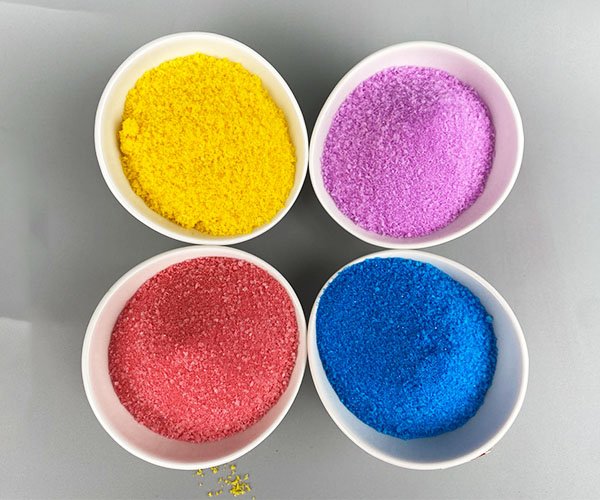Fertilizer production and storage often face issues like caking, gas expansion, and precipitation, which can affect product quality and efficiency. Below is a detailed explanation of these problems and their solutions.
I. Caking Problem of Fertilizer
Caking in fertilizers usually occurs during processing, storage, and transportation. This is primarily caused by the hygroscopic nature of fertilizer particles, which absorb moisture, dissolve on the surface (hygroscopicity), evaporate, and then recrystallize, forming crystal bridges that cause small particles to agglomerate into larger clumps.
Causes of Caking:
- Raw Material Properties: Many raw materials used in fertilizer production, such as ammonium salts, phosphates, trace element salts, and potassium salts, contain crystallization water and are prone to absorbing moisture, leading to caking. For instance, ammonium sulfate is prone to caking, and when phosphates and trace elements interact, they can form insoluble substances that cake. Urea can also cause caking when it interacts with trace elements, as urea displaces crystallization water from these salts, creating a paste that subsequently solidifies.
- Humidity and Temperature: Fertilizer production is typically carried out in non-closed environments, and higher humidity increases the likelihood of caking. Conversely, in dry conditions or when raw materials are dried, caking is less likely to occur. High temperatures (above 50°C) reduce the chances of caking by promoting moisture evaporation.
- Pressure: Increased external pressure makes crystals come into contact with one another more easily, leading to caking. Lower pressure minimizes the risk of caking.
- Storage Time: The longer fertilizer is stored, the more likely it is to cake. Freshly produced fertilizer is less prone to caking.
Solutions to Prevent Caking:
- Choose Suitable Raw Materials: Select materials that are less prone to caking, such as dry trace element fertilizers (iron, copper, manganese, zinc, and borates). Fertilizers based on humic acid or amino acids are also less likely to cake.
- Appropriate Production Timing: In China, the rainy season is concentrated in the summer (June to August), and high temperatures also occur during this period. Therefore, producing fertilizers in spring, late autumn, or winter, when the humidity is lower, is ideal to prevent caking.
- Use Anti-Caking Agents: Add substances like talc, humic acid, or other powders that can prevent particles from agglomerating. These materials act as barriers between particles to prevent the formation of crystal bridges.
- Proper Packaging: Use breathable packaging materials to prevent moisture absorption and excessive compression during storage and transportation, which can lead to caking.
II. Gas Expansion Problem of Fertilizer
Gas expansion in fertilizers typically results from chemical reactions, such as organic matter fermentation, urea hydrolysis, and interactions with certain fillers. This can cause the fertilizer to expand, potentially damaging packaging and decreasing product stability.
Causes of Gas Expansion:
- Fermentation of Organic Materials: When fertilizers contain organic materials, they may undergo fermentation, producing carbon dioxide (CO₂) gas, especially in warm environments.
- Urea Hydrolysis: Urea can break down into ammonia and carbon dioxide, particularly in high-temperature environments.
- Calcium Carbonate Fillers: Some fillers, like calcium carbonate, can release carbon dioxide when interacting with water.
- Borax with Carbonates: Small amounts of borax containing carbonates can also produce gas.
- Ammonium Salts and Alkaline Materials: When ammonium salts react with alkaline substances or are exposed to high temperatures, gas expansion can occur.
Solutions to Prevent Gas Expansion:
- Raw Material Compatibility: Ensure that raw materials are compatible and do not engage in chemical reactions that produce gas.
- Use Inert Fillers: Choose inert materials like white carbon black, talc, or starch-based fillers that do not react with other components.
- Use Qualified Raw Materials and Packaging: Ensure that raw materials and packaging are free from impurities like calcium carbonate and that packaging is breathable to allow gas to escape.
- Control pH of Solutions: Maintain the proper pH in fertilizer solutions to prevent undesirable reactions that lead to gas expansion.
III. Precipitation Problem
Precipitation in fertilizers occurs when certain raw materials, which are not highly soluble in water, are added in excess, causing them to form insoluble precipitates.
Causes of Precipitation:
- Excessive Use of Poorly Soluble Materials: Some materials, such as borax and boric acid, are poorly soluble in water at room temperature. If used in excess, they may precipitate. For instance, borax dissolves in water at a rate of 30–50 kg per ton, and exceeding this limit results in precipitation.
- Chemical Reactions Between Materials: Certain materials, such as zinc, copper, iron, manganese, and phosphate compounds, react in solution and form insoluble precipitates. For example, zinc, copper, and iron ions will form precipitates when exposed to phosphates or borates.
- Salt-Out Phenomenon: Some materials, like amino acids and zinc sulfate, can dissolve well in water. However, when mixed, zinc sulfate may precipitate out the amino acids. Similar salt-out phenomena can occur with other combinations, such as zinc, copper, iron, and manganese with amino acids or humic acids.
- pH of the Solution: Some materials dissolve better in acidic conditions, while others, such as humic acid, dissolve better in alkaline conditions. An incorrect pH can lead to precipitation.
Solutions to Prevent Fertilizer Precipitation:
- Choose Appropriate Materials: Select materials that do not react to form precipitates. Avoid using materials that are poorly soluble in water in high concentrations.
- Proper Ratio of Materials: Ensure the correct proportions of materials are used to prevent saturation and salt-out phenomena.
- Adjust Solution pH: Maintain the correct pH to ensure that all components dissolve properly and do not precipitate.
- Add Protective Additives: Use additives that help maintain the stability of the solution and prevent unwanted precipitation.
- Add Solubility Enhancers: Use solvents or other substances that increase the solubility of poorly soluble materials, preventing precipitation.
By carefully considering the factors that contribute to caking, the quality and stability of fertilizers can be significantly improved. These measures will ensure that fertilizers perform as intended, providing efficient and effective nourishment for crops.


